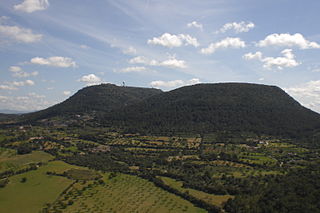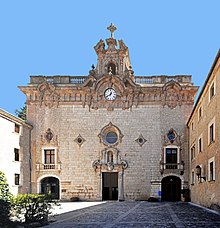
The term Black Madonna or Black Virgin tends to refer to statues or paintings in Western Christendom of the Blessed Virgin Mary and the Infant Jesus, where both figures are depicted with dark skin. The Black Madonna can be found both in Catholic and Orthodox countries.

Valldemossa is a village and municipality on the island of Majorca, part of the Spanish autonomous community of the Balearic Islands. It is famous for one landmark: the Royal Charterhouse of Valldemossa, built at the beginning of the 14th century, when the mystic and philosopher Ramon Llull lived in this area of Majorca.

Mount Kōya is a large temple settlement in Wakayama Prefecture, Japan to the south of Osaka. In the strictest sense, Mount Kōya is the mountain name (sangō) of Kongōbu-ji Temple, the ecclesiastical headquarters of the Kōyasan sect of Shingon Buddhism.

The Sanctuary of Saint Michael the Archangel is a Roman Catholic shrine on Mount Gargano, Italy, part of the commune of Monte Sant'Angelo, in the province of Foggia, northern Apulia. It has the dignity of a minor basilica.

Canillo is one of the parishes of Andorra. Canillo is also the name of the main town of the parish. The parish is considered the religious center of Andorra with the Sanctuary and Chapel of Our Lady of Meritxell, patron saint of Andorra, and contains one of the best-preserved romanesque churches in the Pyrenees, Sant Joan de Caselles. It has a population of 4,826, as of 2011. Despite having a tourist vocation, the parish of Canillo still retains many livestock and agricultural traits.

Our Lady of Montserrat or the Virgin of Montserrat is a Marian title associated with a statue of the Madonna and Child venerated at the Santa Maria de Montserrat monastery on the Montserrat Mountain in Catalonia, Spain. She is the Patron Saint of Catalonia, an honour she shares with Saint George. Miracles have been attributed to the statue.

Siddhachalam is the first Jain Tirtha located outside of India. Founded in 1983 by Sushil Kumar, it is located on a 108-acre (44ha) site in rural New Jersey, United States. Siddhachalam literally means the abode of liberated souls.

Algaida is a municipality on the Spanish Balearic island of Majorca. It has an area of 89.70 km2 with 4,528 inhabitants.

Artà is one of the 53 independent municipalities on the Spanish Balearic island of Majorca. The small town of the same name is the administrative seat of this municipality in the region (Comarca) of Llevant.

Chavagnes International College is an independent Catholic secondary school for boys, located in Chavagnes-en-Paillers, France. Founded in 1802 by Louis-Marie Baudouin the school was re-fashioned an "international college" in 2002. The school's language of instruction is English, and it prepares pupils for British GCSEs and A-levels, with the French Brevet and Baccalauréat as options.

Christianity has a strong tradition of pilgrimages, both to sites relevant to the New Testament narrative and to sites associated with later saints or miracles.

Chalma is a small community, which is part of the municipality of Malinalco, Mexico State. Its small population is almost completely dedicated to the pilgrims who come to visit the Sanctuary of Chalma, the second most-important pilgrimage site in Mexico. The sanctuary is dedicated to an image of what many people describe as a "black Christ" on a cross that legend says miraculously appeared in an area cave where the worship of a deity commonly known as Oxtoteotl used to take place. Some contend that as Oxtoteotl is an aspect of Tezcatlipoca, the "Smoking Mirror," then the "black Christ" is really Tezcatlipoca, which the Spanish friars superimposed on the existing representation of Tezcatlipoca in order to convert the natives. Pilgrimages to this Christian sanctuary follow many of the patterns of the prehispanic rituals, including walking the narrow paths to the town itself, bathing in the waters of a special fresh-water spring and dancing at the sanctuary.

The Valldemossa Charterhouse is a palace in Valldemossa, Mallorca that was residence of the king Sancho of Majorca former royal residence and Royal Charterhouse.

The Santuari de Bellmunt is a sanctuary in the municipality of Sant Pere de Torelló (Osona), which is located on top of the Serra of Bellmunt at 1246 m altitude. There is a viewpoint from where visitors can see the plain of Vic, the Pyrénées, the Ges Valley, and Bisaura. Along the sanctuary is a refuge and a restaurant, all built on the rock. It can be accessed on foot or by car from Sant Pere de Torelló, and from Vidrà only on foot. The image of the Lady of Bellmunt is a 22 cm painted statue of Alabaster.
The prehistoric site of Son Oleza is a prehistoric "Beaker culture" dolmen and associated settlement site on the Spanish island of Mallorca. It is near to the village of Valldemossa on the island's north-west facing coast. The site is named after the nearby place of Son Oleza.

The Hülfensberg is a 448 m high, heavily wooded mountain in the Geismar municipality in the Eichsfeld district, Thuringia, Germany. The mountain has been a pilgrimage site since the late Middle Ages, and on its summit are a church containing a 12th-century crucifix, a Franciscan friary, a chapel dedicated to Saint Boniface, and a large free-standing cross.

The Santa Cova de Montserrat is the hillside cave on Montserrat where the Virgin of Montserrat was traditionally hidden during the Moorish invasions and later discovered by shepherds in 880. Its discovery made Montserrat into a pilgrimage destination, and led to the founding of the Santa Maria de Montserrat Abbey.

The Asclepieion of Athens was the sanctuary built in honour of the gods Asclepius and Hygieia, located west of the Theatre of Dionysos and east of the Pelargikon wall on the southern escarpment of the Acropolis hill. It was one of several asklepieia in the ancient Greek world that served as rudimentary hospitals. It was founded in the year 419–18 BCE during the Peloponnesian War, perhaps as a direct result of the plague, by Telemachos Acharneas. His foundation is inscribed in the Telemachos Monument, a double-sided, marble column which is topped by reliefs depicting the arrival of the god in Athens from Epidaurus and his reception by Telemachos. The sanctuary complex consisted of the temple and the altar of the god as well as two galleries, the Doric stoa which served as a katagogion for overnight patients in the Asklepieion and their miraculous healing by the god, and the Ionic Stoa that served as a dining hall and lodging for the priests of Asclepius and their visitors.
Pere Riutort i Mestre was a Majorcan priest, pedagogue, philologue, and liturgist. He was one of the main promoters of the Catalan language in Majorca and also in the Valencian Country, where he had lived since 1971.



















